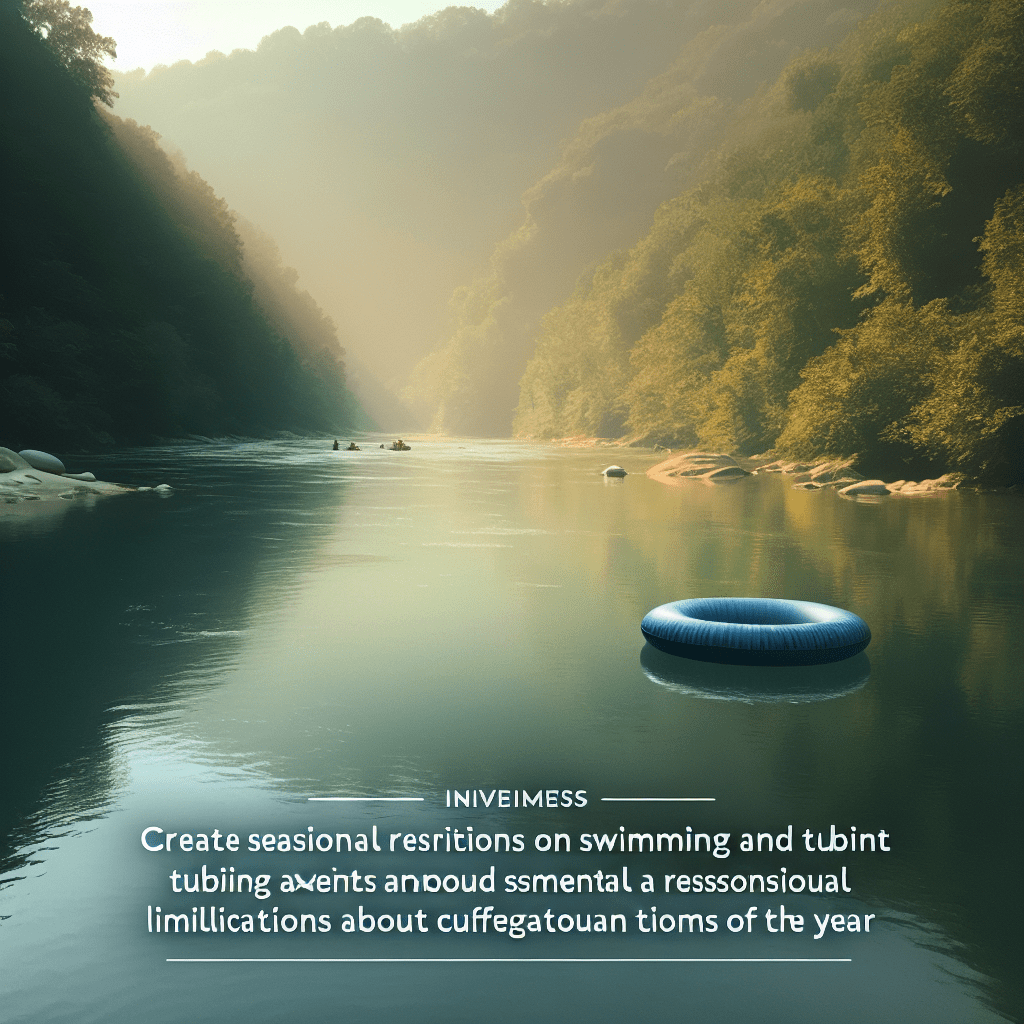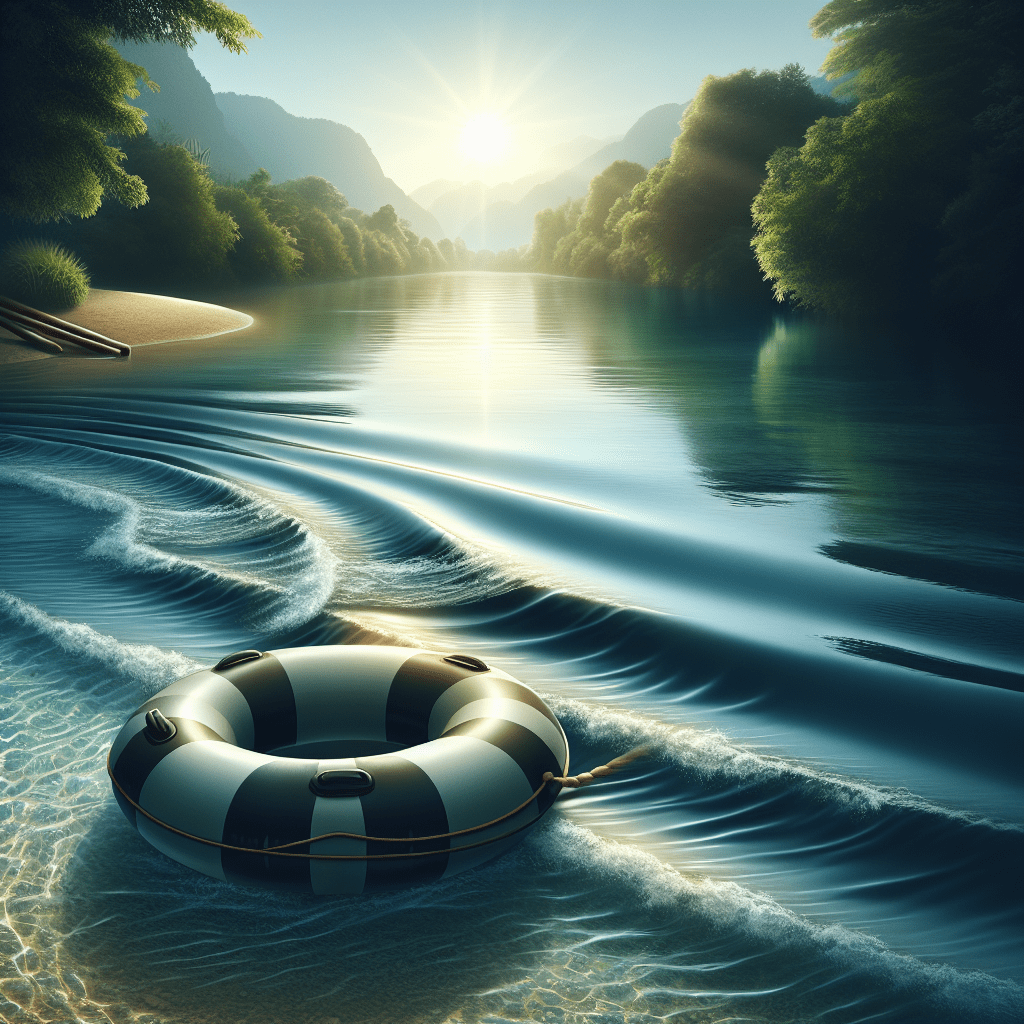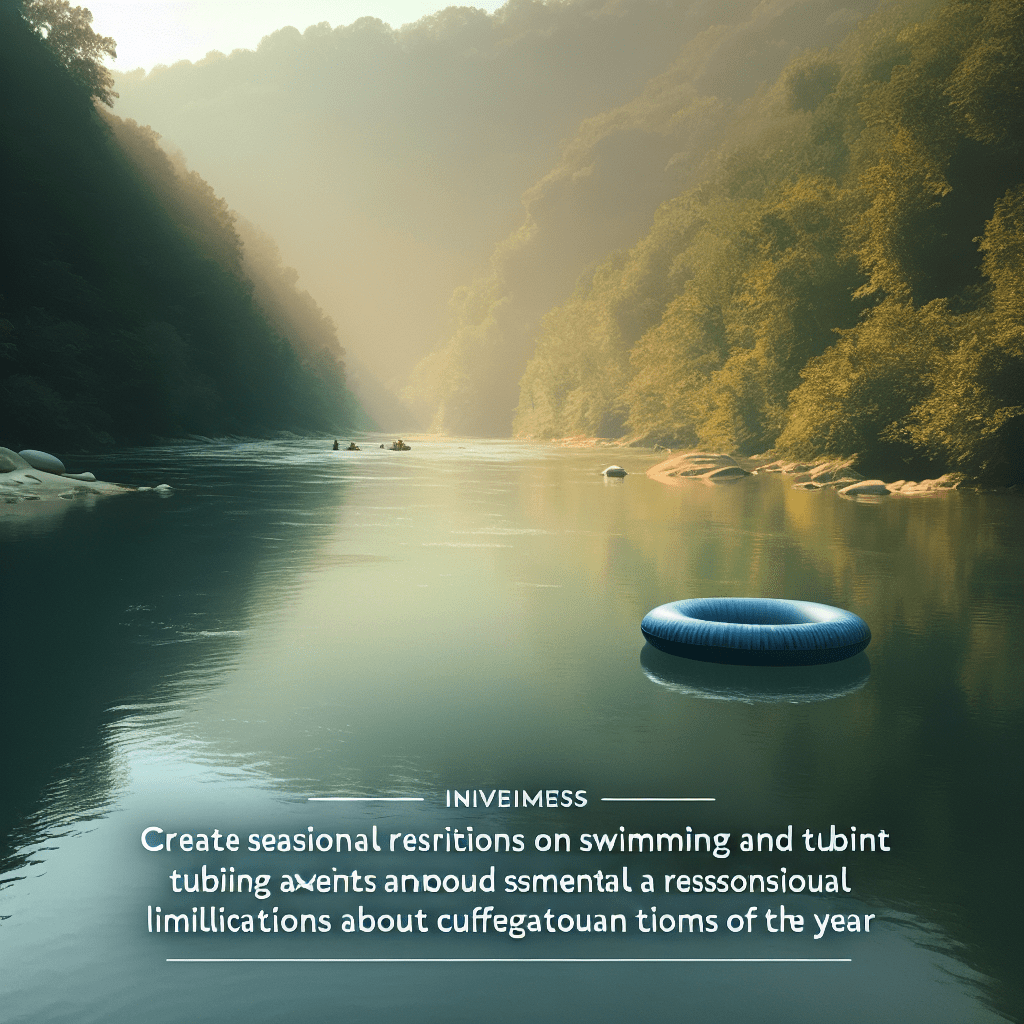
When it comes to soaking up the sun and enjoying the refreshing waters of the river, we often find ourselves wondering if there are any limitations on swimming or tubing during specific times of the year. In this article, we explore the rules and regulations surrounding river activities, providing valuable insights on whether there are any restrictions to be aware of. So, whether you’re planning a summer adventure or simply curious about the guidelines in place, join us as we dive into the topic of seasonal restrictions for swimming and tubing in the river.

Overview of swimming and tubing in the river
Swimming and tubing in the river are popular recreational activities enjoyed by people of all ages. They provide a refreshing and enjoyable way to beat the heat and connect with nature. Whether you choose to swim or tube, the experience of being in the water surrounded by the beauty of the river can be truly invigorating. However, it is important to be mindful of certain factors that can affect the safety and enjoyment of these activities. Understanding the definition of swimming and tubing, the popularity of these activities, and the importance of knowing restrictions is essential for a fun and safe experience.
Definition of swimming and tubing
Swimming refers to the act of moving through water using one’s body, while tubing involves sitting in a large inflatable tube and floating along the river’s current. Both activities offer unique experiences and have their own set of benefits. Swimming allows you to navigate the water freely while tubing provides a more relaxed and leisurely ride. Regardless of which activity you choose, it is vital to be aware of your swimming abilities and understand the risks associated with the river’s conditions.
Popularity of swimming and tubing in the river
Swimming and tubing in the river have gained immense popularity over the years. The allure of the water, coupled with the opportunity to enjoy the outdoors, attracts numerous individuals and families seeking a break from their daily routines. River swimming and tubing offer a refreshing and rejuvenating experience, fostering a sense of camaraderie and adventure among participants. The availability of scenic rivers and suitable areas for these activities further contributes to their appeal.
Importance of knowing restrictions
While swimming and tubing in the river can be immensely enjoyable, it is crucial to be aware of any restrictions that may be in place. Understanding and adhering to these restrictions helps ensure the safety of individuals, protects the environment, and maintains the balance between recreational activities and wildlife preservation. Ignoring restrictions could lead to hazardous situations, harm to natural habitats, and negatively impact the experience for others. By being informed about the regulations and limitations, we can promote responsible and sustainable outdoor recreation.
Environmental factors affecting swimming and tubing
Before heading out to swim or tube in the river, it is important to consider the environmental factors that can influence the overall experience and safety. These factors include water temperature, water flow rate, and weather conditions.
Water temperature
The temperature of the river water can vary greatly depending on the season, location, and local climate. Cold water can pose a significant risk, causing hypothermia or cramps if individuals are not adequately prepared. On the other hand, extremely hot water can lead to dehydration and heatstroke. It is essential to be mindful of water temperature and dress appropriately for the conditions to prevent any adverse effects on our health.
Water flow rate
The flow rate of the river’s current greatly impacts swimming and tubing. Swift currents can make it challenging to navigate and increase the risk of accidents or injuries. Conversely, slow currents may require extra effort to propel oneself or the tube forward. Additionally, changes in water flow, such as rapids or waterfalls, should be approached with caution. Monitoring the flow rate and understanding our abilities as swimmers or tubers is crucial for a safe and enjoyable experience.
Weather conditions
The weather plays a significant role in swimming and tubing safety. Thunderstorms, heavy rainfall, or sudden changes in weather patterns can create dangerous situations in the water. Being aware of the forecast and making informed decisions based on the prevailing weather conditions is essential. Postponing your plans or seeking shelter during unfavorable weather not only ensures personal safety but also preserves the integrity of the river’s ecosystem.
Regulations and restrictions
To maintain the safety and sustainability of swimming and tubing in the river, various regulations and restrictions are put in place by authorities. These restrictions may come in the form of legal requirements, local laws and ordinances, policies set by parks or recreational areas, and designations for protected areas and wildlife habitats. Understanding and adhering to these restrictions is crucial to protect both individuals and the natural environment.
Legal restrictions
Certain legal restrictions may be in place regarding swimming and tubing in the river. These restrictions can include age limits, licensing requirements, and designated areas for recreational activities. It is important to familiarize ourselves with the local laws and regulations to ensure compliance and avoid any potential legal repercussions.
Local laws and ordinances
In addition to legal restrictions, local communities often have their own laws and ordinances regarding swimming and tubing in the river. These can include rules regarding noise levels, littering, and alcohol consumption. Respecting these laws not only maintains harmony within the community but also contributes to a pleasant experience for all river users.
Park or recreational area policies
Parks or recreational areas may have specific policies in place to regulate swimming and tubing activities. These policies can relate to access points, designated swim or tube areas, or specific operating hours. Being aware of and following these policies helps preserve the park’s natural beauty, minimize conflicts between different recreation activities, and ensure the safety of all visitors.
Protected areas and wildlife habitats
Some rivers may flow through protected areas or serve as vital habitats for wildlife. In such cases, additional restrictions may be enforced to protect the ecological integrity of these areas. These restrictions can include limited access, regulated water activities, or seasonal closures to minimize disturbances to wildlife populations. Respecting these restrictions fosters environmental stewardship and contributes to the conservation of natural habitats.
Seasonal restrictions
The different seasons bring about unique challenges and considerations for swimming and tubing in the river. Understanding the seasonal restrictions is essential to adapt to changing conditions and ensure a safe and enjoyable experience throughout the year.
Spring season restrictions
Spring brings a vibrant burst of life to rivers, but it also presents specific challenges for swimmers and tubers. Potential hazards such as fast-flowing water, increased debris, and changing water levels can pose risks. The melting snow and spring rains can cause the river to rise rapidly, leading to stronger currents. Cold water conditions may also persist from the winter season, requiring proper protection to avoid hypothermia. Monitoring advisories and warnings issued by local authorities is crucial during this season.
Summer season restrictions
Summer is a popular time for swimming and tubing. However, the increased popularity also brings along some restrictions. Crowds and overcrowding can pose safety concerns, especially in areas with limited space or high visitor numbers. Additionally, water quality issues such as bacterial contamination can arise due to increased human activities. River traffic, including motorized boats or kayakers, may also increase during this season. Being mindful of these restrictions and taking necessary precautions ensures a safe and enjoyable experience for everyone.
Autumn season restrictions
As autumn arrives, the conditions in the river begin to change. Changing water levels, foliage, and debris become more prevalent during this season. Floods or heavy rains can cause unexpected fluctuations in water levels, making swimming or tubing more hazardous. Falling leaves and branches can create obstacles in the water, affecting navigation for swimmers and tubers. Additionally, some areas may have designated restrictions to protect wildlife during their breeding or migration seasons. Staying vigilant and respecting these restrictions helps ensure a pleasant and safe experience during the autumn season.
Winter season restrictions
Swimming and tubing in the river during the winter season pose unique challenges due to extreme cold temperatures and icy or frozen water conditions. It is essential to exercise caution and consider personal safety as well as limited access and services. Limited or no lifeguard coverage, reduced visibility, and unpredictable ice conditions are potential hazards during this season. It is advisable to refrain from swimming or tubing in the river during winter unless you are adequately prepared, experienced, and aware of the risks involved.

Safety tips for swimming and tubing in the river
To ensure a safe and enjoyable experience when swimming and tubing in the river, it is essential to follow some safety guidelines. These tips can help minimize the risk of accidents or injuries and maximize our enjoyment of the activity.
Checking water conditions and forecasts
Before heading out, it is important to check the water conditions and weather forecasts for the day. Pay attention to advisories or warnings issued by local authorities regarding water quality, flow rate, or potential hazards. Being informed about the current conditions helps us make informed decisions and adjust our plans accordingly.
Using proper safety equipment
When swimming or tubing in the river, it is recommended to use appropriate safety equipment. Life jackets or personal flotation devices (PFDs) should be worn at all times, especially for individuals who are not strong swimmers. Tubers should also consider wearing helmets to protect against head injuries, particularly in areas with rapids or rocky sections. Having the right equipment significantly enhances our safety and peace of mind.
Knowing personal swimming abilities
Understanding our own swimming abilities and limitations is crucial in ensuring a safe experience. It is essential to be honest with ourselves and refrain from attempting activities beyond our skill level. If we are uncertain about our abilities, swimming lessons or seeking guidance from experienced individuals can help build confidence and competence in the water.
Buddy system and supervision
Swimming or tubing with a buddy or in a group adds an extra layer of safety. Having someone to watch out for each other and provide assistance in case of an emergency can be lifesaving. Additionally, children should always be supervised by responsible adults to prevent accidents and ensure their well-being.
Being aware of potential dangers
When swimming or tubing in the river, it is important to be aware of potential dangers. These can include submerged objects, strong currents, or sudden changes in water depth. Observe the surroundings and be proactive in identifying and avoiding potential hazards. This awareness ensures our safety and prevents unnecessary accidents.
Following instructions and signs
Paying attention to instructions and signage provided by the park or recreational area is crucial for our safety. Signs may indicate areas with prohibited swimming or tubing, hazards to be aware of, or rules and regulations specific to the location. Ignoring these instructions can lead to accidents or negative consequences for ourselves and others.
Benefits of swimming and tubing
Swimming and tubing in the river offer numerous benefits beyond just recreation and enjoyment. Participating in these activities contributes to our physical health, mental and emotional well-being, and provides an opportunity to connect with nature and engage in family and social activities.
Physical health benefits
Swimming and tubing are excellent forms of exercise that engage multiple muscle groups and promote cardiovascular fitness. They help improve stamina, strength, and flexibility while being low-impact on joints. These activities also offer resistance, which enhances muscle tone and endurance. Engaging in regular swimming or tubing sessions can lead to improved overall fitness and contribute to a healthy lifestyle.
Mental and emotional well-being
Being in and around water has been shown to have a calming effect on the mind and reduce stress levels. Swimming and tubing provide an opportunity to disconnect from daily worries and immerse oneself in the beauty of nature. The rhythmic movements in the water and the soothing sounds of the river can promote relaxation and increase feelings of well-being. These activities also provide a sense of accomplishment, boosting self-esteem and mental clarity.
Connection with nature
Swimming and tubing in the river allow us to experience firsthand the beauty and serenity of the natural environment. The sights, sounds, and sensations of being in the water create a deep connection with nature. It offers a chance to appreciate the wonders of aquatic ecosystems and the diversity of life they support. Immersed in the river, we gain a renewed sense of appreciation for the importance of environmental conservation and our role in protecting these valuable resources.
Family and social activities
Swimming and tubing activities are excellent opportunities for families and friends to connect and bond. They encourage quality time spent together, away from the distractions of technology and daily routines. Sharing experiences in the river strengthens relationships, opens up channels for communication, and creates lasting memories. Whether it’s a family outing, a gathering of friends, or meeting new people at a popular swim or tube spot, these activities foster a sense of community and camaraderie.
In conclusion, swimming and tubing in the river offer a multitude of benefits and enjoyable experiences. However, it is important to be aware of the environmental factors, regulations, and restrictions that can affect safety and sustainability. By understanding the seasonal restrictions, following safety tips, and respecting the natural environment, we can ensure that swimming and tubing in the river remain enjoyable activities for all, while preserving the beauty of these natural resources for future generations.